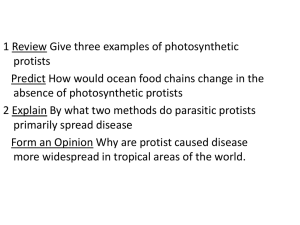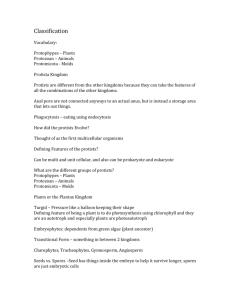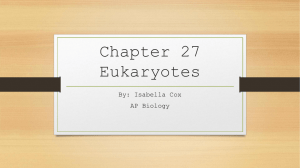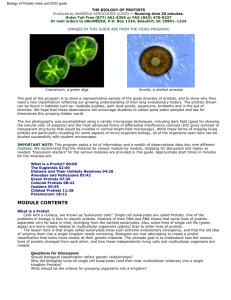Microscopy of Protists
advertisement
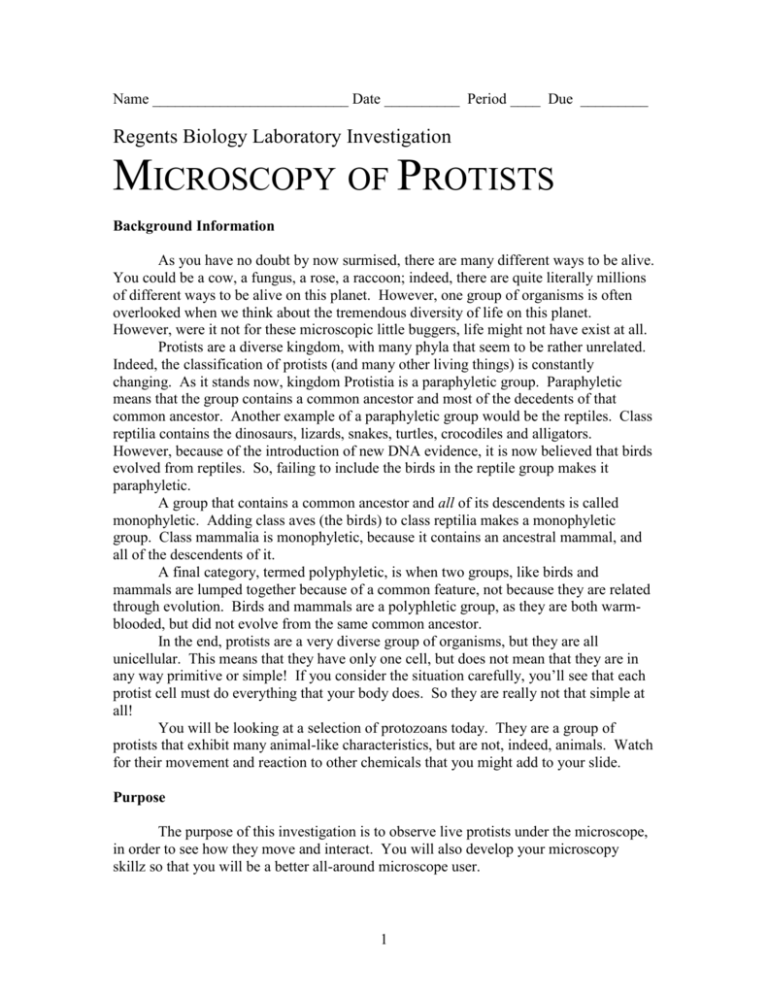
Name __________________________ Date __________ Period ____ Due _________ Regents Biology Laboratory Investigation MICROSCOPY OF PROTISTS Background Information As you have no doubt by now surmised, there are many different ways to be alive. You could be a cow, a fungus, a rose, a raccoon; indeed, there are quite literally millions of different ways to be alive on this planet. However, one group of organisms is often overlooked when we think about the tremendous diversity of life on this planet. However, were it not for these microscopic little buggers, life might not have exist at all. Protists are a diverse kingdom, with many phyla that seem to be rather unrelated. Indeed, the classification of protists (and many other living things) is constantly changing. As it stands now, kingdom Protistia is a paraphyletic group. Paraphyletic means that the group contains a common ancestor and most of the decedents of that common ancestor. Another example of a paraphyletic group would be the reptiles. Class reptilia contains the dinosaurs, lizards, snakes, turtles, crocodiles and alligators. However, because of the introduction of new DNA evidence, it is now believed that birds evolved from reptiles. So, failing to include the birds in the reptile group makes it paraphyletic. A group that contains a common ancestor and all of its descendents is called monophyletic. Adding class aves (the birds) to class reptilia makes a monophyletic group. Class mammalia is monophyletic, because it contains an ancestral mammal, and all of the descendents of it. A final category, termed polyphyletic, is when two groups, like birds and mammals are lumped together because of a common feature, not because they are related through evolution. Birds and mammals are a polyphletic group, as they are both warmblooded, but did not evolve from the same common ancestor. In the end, protists are a very diverse group of organisms, but they are all unicellular. This means that they have only one cell, but does not mean that they are in any way primitive or simple! If you consider the situation carefully, you’ll see that each protist cell must do everything that your body does. So they are really not that simple at all! You will be looking at a selection of protozoans today. They are a group of protists that exhibit many animal-like characteristics, but are not, indeed, animals. Watch for their movement and reaction to other chemicals that you might add to your slide. Purpose The purpose of this investigation is to observe live protists under the microscope, in order to see how they move and interact. You will also develop your microscopy skillz so that you will be a better all-around microscope user. 1 Materials Microscope Methyl Cellulose Various chemicals Cover slips Droppers Procedure Note: When working with live organisms, even small ones, work carefully and humanly. Do not intentionally inflict harm on any living thing. Make sure that you carefully wash your hands after working with anything living. 1. Obtain a slide, and place a drop of the protozoan solution on it. Usually, the little buggers like to hang out near the rice grains in the jar, or in the bottom corners. DO NOT jostle the solution around! 2. Add a cover slip, and observe the specimens. 3. You may add a dilute solution of methyl cellulose to your slide to try and slow the organisms down. This will make them easier to observe. 4. If you wish, you may devise a quick experiment involving the protists. Adding another chemical or changing the conditions (light, pH, temperature) are always good things to try. You may also take a picture or video of your protists with the digital scope. 5. You may rinse the slides off in the sink, and return them to the bench when you are finished. 6. Carefully store your microscope and return all other supplies to the bench. Analysis QUESTION 1: What kinds of locomotion did you see in the protists? QUESTION 2: Could you see any organelles in any of the protists? If so, which ones? QUESTION 3: Why can’t protists get very big? QUESTION 4: What kind of reproduction do protists do? QUESTION 5: Name two things that you would change about this lab if you could. 2




